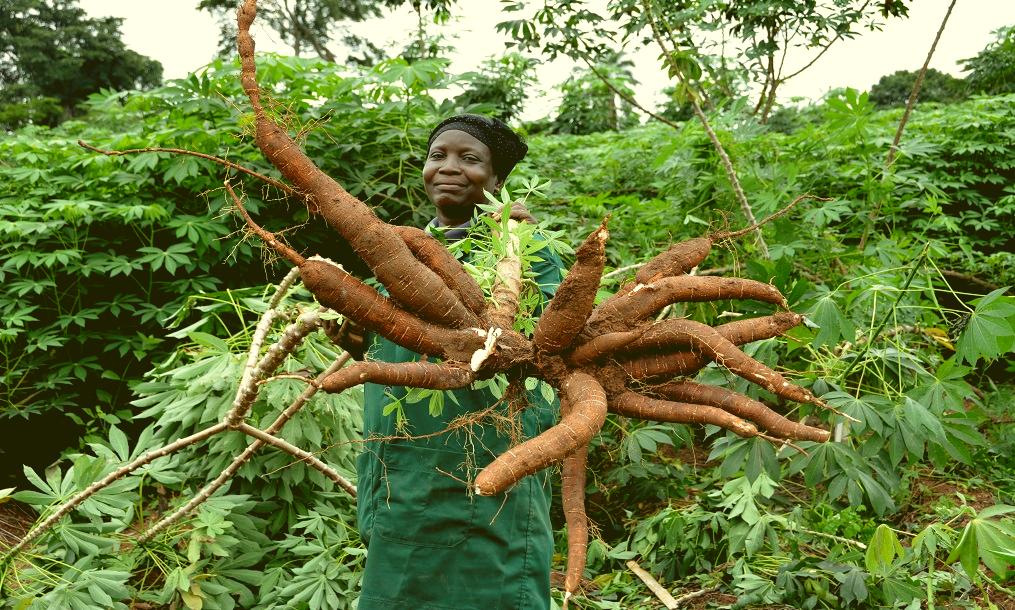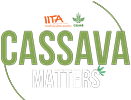
Background
Worldwide cassava is grown on over 12 million hectares and over 500 million people depend on cassava in Africa. Cassava is a perennial root crop that is grown as a long-term annual in over 90 tropical countries. Cassava serves as a staple crop providing essential dietary nutrients to a large portion of the population in countries where it is grown. Cassava not only provides direct dietary needs of a large portion of the world’s population but it increasingly provides income to many farmers, a large portion of whom would be considered small-holder farmers. A number of initiatives are developing industrial scale use of cassava, including in food processing, baking and brewing, leading to increased demand. There is increasing research to explore value addition for new cassava products increasing its economic value. However, many issues face producers of cassava that must be addressed for sustainable production and income security including soil and nutrient management, availability of improved germplasm and pest management, the most prevalent and common are weeds. For example, Nigeria grows over 50% of the world’s cassava with about 4.5 million farmers involved who grow cassava on 3.8 million hectares.
Weeds and cassava
Weeds, which grow continuously throughout the 10-12 month growing cycle include difficult to manage annual and perennial species. Weeds not only reduce yields, but weeding, which is mostly done by hand hoeing, takes 50-80% of the total labor budget of the average farmer. Women contribute more than 90% of the hand-weeding labor and about 69% of farm children between the ages of 5-14 are forced to skip classes at school to engage in weeding of the cassava crop. In Nigeria, the average cassava yield is 8 tons per hectare or less than ½ that of more advanced production systems in Asia (FAO, 2014), primarily because of weeds that compete with the crop for essential growth factors and reduce yields because of poor weed management practices and poor timing of removal. Improved weed management techniques including more systematic integrated weed control tactics are needed, not only in Nigeria, but in other countries in sub-Saharan Africa that would reduce the menace of weeds and increase yields and minimize the drudgery of hand weeding by women and children, thus freeing the labor force to pursue more productive farming practices that result in greater economic opportunities for each farmer while releasing children to greater educational experiences.
Cassava production is mainly concentrated in the tropical regions of the world with three major areas producing the majority of the crop. Africa grows about 50% of the world cassava with the leading countries being Nigeria, Congo D.R., Ghana, Tanzania, Mozambique, Uganda and Madagascar, Southeast Asia which grows 30% of the world cassava where Thailand and Indonesia are major producers and Brazil in Latin America which grows about 20% of the world cassava.
Global share of cassava production
Weed management offers exciting possibilities for expansion of herbicide availability for chemical companies. Globally, land area under cassava production compares favorably with some major staple crops such as maize, wheat and rice, yet herbicide availability within cassava are presently limited. In Nigeria, the primary herbicides used are atrazine, metolachlor, glyphosate and paraquat and within the farming community, less than 50% of them use herbicides routinely, instead they manage weeds by hand hoeing. The problem is even more serious when considering how farmers prepare their fields. Field preparation and removal of problem weeds, especially perennial grasses and broadleaves, is poor. Fields are mostly cultivated with hand hoes and field preparation often does not include removal of existing perennial weeds. Research by IITA in Nigeria has shown that proper field preparation including application of glyphosate to existing weeds followed by plowing, harrowing, ridging and removal of existing perennial weed propagules leads to lowered weed presence in the cassava field. If proper field preparation and rouging are coupled with use of preemergence herbicides and follow-up application of postemergence herbicides and/or use of mechanical weeding, cassava can become more productive for smallholders. There is also the potential for mechanization on larger farms resulting in higher yields and a reduction in the drudgery and for women and children that is an inevitable consequence of hand hoeing. In other parts of the cassava growing world, outside of Africa, a few more herbicides exist and some improved use of mechanical tillers is more common but even in these regions, the need for improved herbicide availability is needed.
The Cassava Weed Management Project
A current project lead by the International Institute of Tropical Agriculture (IITA) located in Ibadan Nigeria and funded by the Bill and Melinda Gates foundation with collaborations from the following institutions in Nigeria: Federal Ministry of Agriculture (FMARD), National Root Crops Research Institute (NRCRI), University of Agriculture Makurdi (UAM), Federal University of Agriculture Abeokuta (FUNAB), National Agency for Food and Drug Administration and Control (NAFDAC), National Environmental Standards and Regulation Enforcement Agency (NESREA), Standards Organization of Nigeria (SON), State Agricultural Development Programme (ADP), Crop Life Nigeria and other NGOs is addressing the weed menace in cassava and in intercropped maize and cassava. Chemical companies have provided samples of herbicides for testing and some applicator training which has been highly appreciated. The project is employing the best-bet agronomic practices, mechanical weed control options, use of safe and environmentally friendly herbicides and integrated weed control measures to address the weed control challenge while preserving the natural resource base. The IITA project major aim is to develop integrated weed management (IWM) techniques that involve the systematic screening of new potential herbicides and testing of mechanical weed management technique and includes the development of weed management techniques that result in the best fit approach for cassava farmers. Project experiments have included techniques for site preparation to reduce problem weeds (field preparation application of broadspectrum herbicides followed by field cultivation with tractors and appropriate implements), planting approaches for best crop establishment techniques (germplasm, planting density, use of ridges) that result in crop competition against weeds, use of premergence and postemergence herbicides, use of mechanical weeders and improved long handles hoes. The experiments included initial research station testing of approaches followed by on-farm farmer cooperative studies which set the stage for farmer and agriculture advisor training on weed knowledge and of proper integrated weed management approaches and especially, safe handling, storage and appropriate application of herbicides. The project aims in the long term to assist the majority of the 4.5 million cassava farmers in Nigeria and includes cooperative agreements with the Nigerian agriculture and regulatory government agencies, impacted farmer organizations, independent farmer groups, NGOs, agriculture crop advisors and chemical companies. The project is over a five year period (2014-2018). The project leaders recognize there are no ‘Silver bullet’ techniques to solve the weed problem but that the development of practical, affordable and profitable techniques will best address weed management in cassava.
Cassava roots demand for industrial sector in Nigeria
Source: www.cassavasummit.com
FCR: Fresh Cassava Roots required

